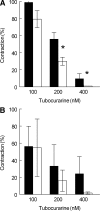The effect of plasma from muscle-specific tyrosine kinase myasthenia patients on regenerating endplates
- PMID: 19745065
- PMCID: PMC2751550
- DOI: 10.2353/ajpath.2009.090040
The effect of plasma from muscle-specific tyrosine kinase myasthenia patients on regenerating endplates
Abstract
Muscle-specific tyrosine kinase (MuSK) is essential for clustering of acetylcholine receptors (AChRs) at embryogenesis and likely also important for maintaining synaptic structure in adult muscle. In 5 to 7% of myasthenia gravis (MG) cases, the patients' blood contains antibodies to MuSK. To investigate the effect of MuSK-MG antibody on synapse regeneration, notexin was used to induce damage to the flexor digitorum brevis muscle. We administered aliquots of MuSK-MG patients' plasma to the flexor digitorum brevis twice daily for a period up to 21 days, and muscles were investigated ex vivo in contraction experiments. AChR levels were measured with (125)I-alpha-bungarotoxin, and endplates were studied with quantitative immunohistochemistry. In normal muscles and in 14-day regenerated muscles, MuSK plasma caused impairment of nerve stimulus-induced contraction in the presence of 0.35 and 0.5 mmol/L Ca(2+) with or without 100 to 400 nmol/L tubocurarine. Endplate size was decreased in regenerated muscles relative to controls; however, we did not observe such differences in muscle not treated with notexin. MuSK plasma had no effect on the amount and turnover rate of AChRs. Our results suggest that anti-MuSK antibodies influence the activity of MuSK molecules without reducing their number, thereby diminishing the size of the endplate and affecting the functioning of AChRs.
Figures




References
-
- Patrick J, Lindstrom J. Autoimmune response to acetylcholine receptor. Science. 1973;180:871–872. - PubMed
-
- Drachman DB. Myasthenia gravis: immunobiology of a receptor disorder. Trends Neurosci. 1983;6:446–451.
-
- Vincent A. Unravelling the pathogenesis of myasthenia gravis. Nat Rev Immunol. 2002;2:797–804. - PubMed
-
- Losen M, Martinez-Martinez P, Phernambucq M, Schuurman J, Parren PW, De Baets MH. Treatment of myasthenia gravis by preventing acetylcholine receptor modulation. Ann NY Acad Sci. 2008;1132:174–179. - PubMed
-
- Heinemann S, Merlie J, Lindstrom J. Modulation of acetylcholine receptor in rat diaphragm by anti-receptor sera. Nature. 1978;274:65–68. - PubMed
Publication types
MeSH terms
Substances
LinkOut - more resources
Full Text Sources
Other Literature Sources
Medical
Research Materials
Miscellaneous

